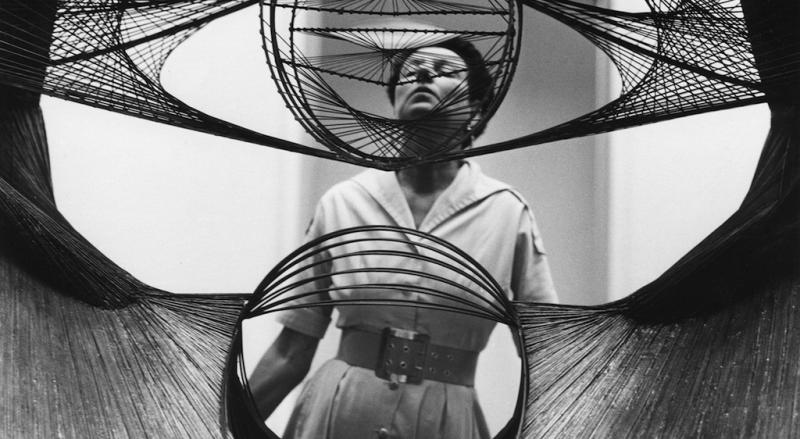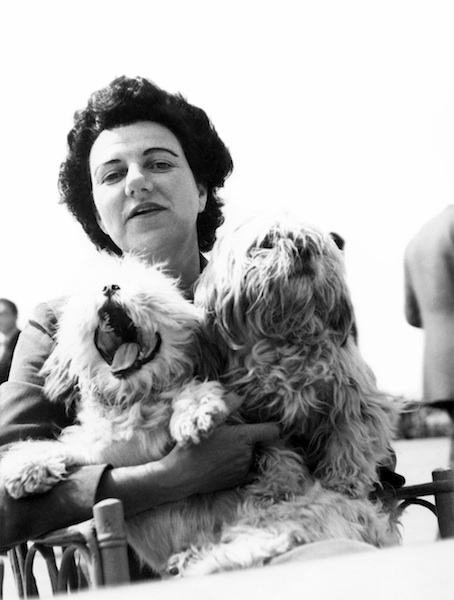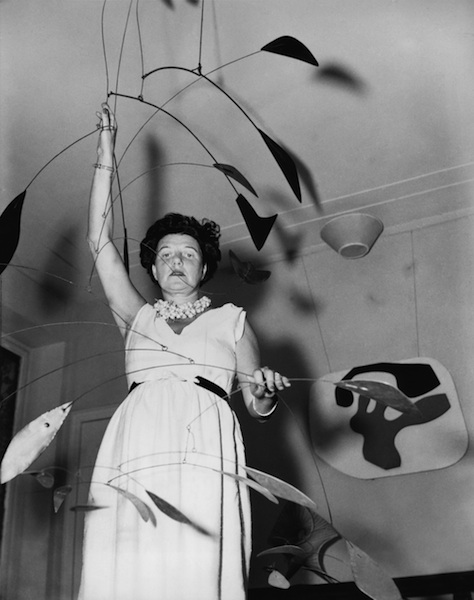Peggy Guggenheim: Art Addict | reviews, news & interviews
Peggy Guggenheim: Art Addict
Peggy Guggenheim: Art Addict
Documentary charts one of modern art's most idiosyncratic champions

The New Yorker Peggy Guggenheim (1898-1979) was the classic poor little rich girl: insecure, a woman with scores, perhaps hundreds of lovers, longing for love, the writer of tell-all memoirs. What sets her apart is that she was also the creator of one of the world’s greatest collections of modern and contemporary western art.
There are not only her massive donations to a variety of museums, but the legendary Peggy Guggenheim collection in her Venetian palazzo on the Grand Canal, one of the most visited modern museums in the world, with some 326 works of art by 100 different artists. La Dogaressa (her affectionate Venetian nickname) is buried in the palazzo garden, along with 14 of her dogs. During her 30 years in Venice she owned more than 50 small fluffy canines (pictured below), undoubtedly the living creatures with whom she had her happiest and least complicated relationships.
 The name Guggenheim implied great wealth, but it was a dysfunctional family, to put it mildly: a profoundly neurotic mother and aunt, and a philandering father who went down with the Titanic, although his mistress – on board as his secretary – survived; her adored sister Bettina died in childbirth, and her other sister probably murdered her two young sons. Peggy’s own difficult, wayward daughter, the beautiful Pegeen, overdosed when 42. Peggy always felt an outsider, both Jewish and plain. And she was – partly due to her adored yet feckless father – one of the poorer Guggenheims.
The name Guggenheim implied great wealth, but it was a dysfunctional family, to put it mildly: a profoundly neurotic mother and aunt, and a philandering father who went down with the Titanic, although his mistress – on board as his secretary – survived; her adored sister Bettina died in childbirth, and her other sister probably murdered her two young sons. Peggy’s own difficult, wayward daughter, the beautiful Pegeen, overdosed when 42. Peggy always felt an outsider, both Jewish and plain. And she was – partly due to her adored yet feckless father – one of the poorer Guggenheims.
The hook for Lisa Immordino Vreeland's documentary is the discovery of hours of audio tapes of interviews Guggenheim did in the last year of her life, with her tell-all biographer Jacqueline Bograd Weld. Weld was elegant, graceful and exquisitely dressed, everything Guggenheim was not. Apparently Peggy had a habit of unconsciously putting her tongue out while speaking, which once pointed out is exceptionally disconcerting.
Vreeland is the grand-daughter in law of Diana Vreeland, the legendary fashion editor, about whom she made her first film; so she is no stranger to the world of strong women in the arts. Her documentary mixes archive photographs and clips from historic Dada and surrealist films, with interviews with curators, socialites, art historians and others. It should be terminally confusing, a bewilderment of points of view from those who knew Guggenheim and those in the know. In fact, the film is remarkably disciplined and always on track, divided into chapters as we move with Guggenheim from New York to Europe – Paris, in its headiest inter-war years, London and the English countryside – back to New York, and finally France again and Venice.
The result is a lucid portrait of a remarkable, sad, mixed-up woman who fulfilled three exemplary roles in the art world. She was a collector who at her height was buying a painting a day – almost all directly from the artists, at times of dire need as World War II was breaking out. She was a patron, who famously commissioned, showed and subsidised the alcoholic genius Jackson Pollock; and a gallerist, who, among other amazing shows, gave the first public airing to Lucian Freud in an exhibition of children’s art in 1939, at her London gallery, Guggenheim Jeune. (Guggenheim with the work of Alexander Calder, pictured below.)
 One amusing sequence sees her almost wresting Brancusi’s Bird in Space from the sculptor, with whom she probably had a fling. Her sexual adventures are mentioned again and again, not only by Guggenheim but by a number of the (male) art historians who are interviewed. One is asked what question he would have liked to ask her; what was Samuel Beckett like in bed, he replies. Guggenheim does not exactly tell us, but evidently their first encounter lasted four days without leaving the hotel room, only opening the door for room service.
One amusing sequence sees her almost wresting Brancusi’s Bird in Space from the sculptor, with whom she probably had a fling. Her sexual adventures are mentioned again and again, not only by Guggenheim but by a number of the (male) art historians who are interviewed. One is asked what question he would have liked to ask her; what was Samuel Beckett like in bed, he replies. Guggenheim does not exactly tell us, but evidently their first encounter lasted four days without leaving the hotel room, only opening the door for room service.
Whether the extraordinary quality of her collection was due to her taste or that of others is questioned; but she had the intelligence to have excellent input. When her plan to have a museum in London was aborted, Herbert Read gave her a list of artists from whom she must purchase in Paris. Picasso was evidently dismissive at one point, when she came a-buying and he told her that “lingerie is on the fifth floor”. Her most influential éminence grise was Marcel Duchamp. And it was Mondrian, looking intently at paintings by Jackson Pollock in Guggenheim’s New York gallery, Art of This Century, who insisted that she take Pollock’s work seriously. So she did, and the rest is history.
In Paris in that dangerous time, she bought for $40,000 or so a collection, we’re told, that can only be valued today in the billions. Whatever her personal insecurities, the artists she supported and collected form much of the canon of classic modernism. It is a unique story, and brilliantly shown.
Overleaf: watch the trailer for Peggy Guggenheim: Art Addict
rating
Explore topics
Share this article
The future of Arts Journalism
You can stop theartsdesk.com closing!
We urgently need financing to survive. Our fundraising drive has thus far raised £49,000 but we need to reach £100,000 or we will be forced to close. Please contribute here: https://gofund.me/c3f6033d
And if you can forward this information to anyone who might assist, we’d be grateful.

Subscribe to theartsdesk.com
Thank you for continuing to read our work on theartsdesk.com. For unlimited access to every article in its entirety, including our archive of more than 15,000 pieces, we're asking for £5 per month or £40 per year. We feel it's a very good deal, and hope you do too.
To take a subscription now simply click here.
And if you're looking for that extra gift for a friend or family member, why not treat them to a theartsdesk.com gift subscription?

Add comment